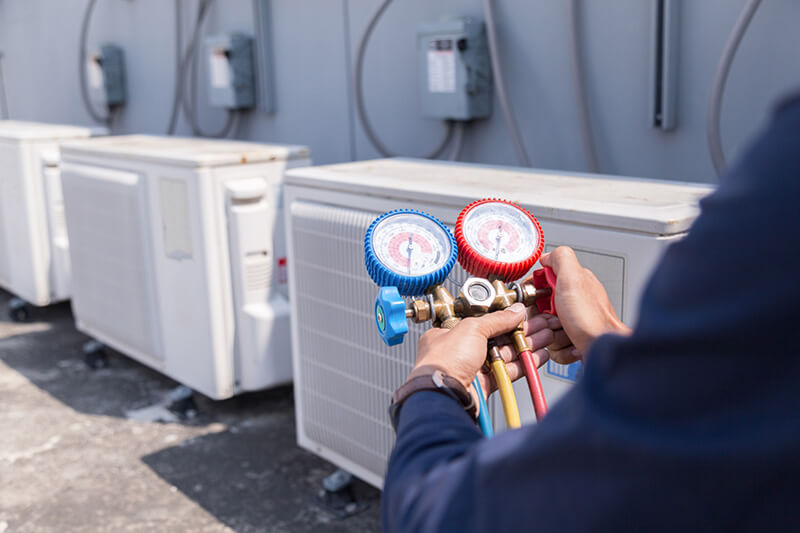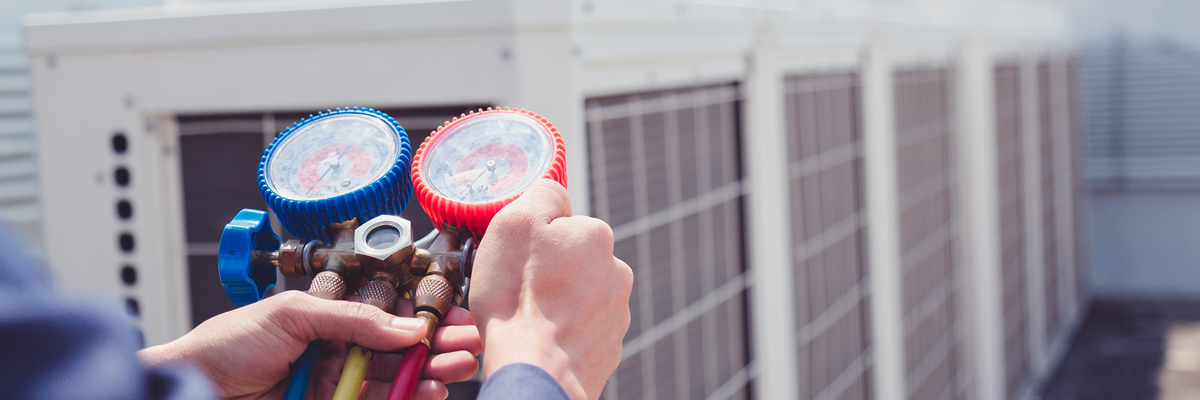Get the Best Results from Your heat pump installation ooltewah tn
Get the Best Results from Your heat pump installation ooltewah tn
Blog Article
Just How a Heatpump and Heater Collaborate to Optimize Your Home's Heating Efficiency
Comprehending exactly how a heatpump and heating system interact is essential for home owners seeking effective home heating options. Each system has its strengths, supplying a well balanced strategy to home comfort. The warm pump stands out in moderate temperatures, while the furnace delivers rapid warmth during extreme cold. This harmony not just lowers power costs yet also improves the life-span of both home appliances. What factors affect this partnership, and just how can home owners optimize their benefits?
Comprehending Warmth Pumps: How They Work
Although several individuals may be unknown with their inner operations, heat pumps play an essential role in modern-day heating unit. These gadgets operate by transferring warm from one location to an additional, using the principles of thermodynamics. In colder months, a heatpump removes warm from the outside air, ground, or water, and transfers it indoors to warm up the home. On the other hand, during warmer months, it can turn around the procedure, working as an air conditioning system by getting rid of heat from inside to the outside.Heat pumps contain an evaporator, growth, compressor, and condenser shutoff. The cooling agent within the system soaks up heat as it evaporates at low temperature levels and pressures. The compressor then enhances the pressure and temperature of the refrigerant, allowing it to release warmth as it condenses. This efficient process can significantly decrease power consumption contrasted to standard heating approaches, making heatpump a sustainable option for environment control in homes.
The Role of Heaters in Home Home Heating
Furnaces play a vital role in home heating by offering a reputable resource of heat throughout the colder months. They run by generating warm via burning or electrical resistance, dispersing it throughout the home using air ducts or glowing systems. The effectiveness of a heating system is frequently measured by its Annual Gas Usage Effectiveness (AFUE) score, which shows how efficiently the system converts fuel right into heat.Furnaces can utilize various power resources, consisting of gas, lp, oil, or electrical energy, allowing house owners to select one of the most suitable alternative for their needs. Unlike heatpump, which may struggle in severe cold, heaters preserve constant performance, making sure that interior temperature levels remain comfortable no matter outside conditions. Additionally, modern heaters typically come geared up with advanced technology, such as smart thermostats and variable-speed blowers, improving their performance and responsiveness. This flexibility makes furnaces a critical element in all-encompassing home heating methods.

Benefits of Using Both Systems Together
Integrating the strengths of both furnaces and warmth pumps can lead to a more efficient and efficient home heating solution. Utilizing both systems allows homeowners to benefit from the heatpump's energy effectiveness during milder temperature levels while relying on the heater for more severe cold problems. This twin technique can significantly lower power prices, as heat pumps consume less electrical power than typical heating approaches when temperature levels are moderate.Additionally, making use of both systems together can boost convenience levels in the home. Heatpump can provide constant, even home heating, while furnaces can quickly raise ambient temperatures when needed. The assimilation of both systems can extend the life expectancy of tools by minimizing wear and tear on each system, as they share the workload. Inevitably, property owners can delight in a well balanced, cost-efficient heating remedy that changes perfectly to varying weather condition conditions, making sure a cozy and welcoming home throughout the winter season.
How Heat Pumps and Furnaces Complement Each Other
When home owners incorporate heatpump and heaters, they produce a complementary furnace that optimizes efficiency and convenience. Heatpump operate by moving heat from the outdoors air or ground, making them extremely reliable in modest environments. They excel during milder temperature levels, supplying economical heating. Alternatively, heaters generate warm through burning or electrical resistance, providing strong, prompt heat throughout extreme cool conditions.The combination of these two systems enables vibrant modifications based on temperature level variations. During warmer months or milder wintertime days, the heat pump can take the lead, saving power and reducing costs. As temperatures drop, the heater can seamlessly involve, making sure constant warmth throughout the home. This harmony not just optimizes energy use however additionally improves the lifespan of both systems, as each unit operates within its suitable performance variety. With each other, they produce a well balanced atmosphere that adjusts to differing climate needs.
Maximizing Effectiveness: Tips for Homeowners
Homeowners can boost their heating efficiency with several useful strategies. Establishing a normal maintenance timetable, integrating clever thermostat innovation, and carrying out efficient insulation and securing remedies are essential actions. These procedures not just enhance convenience however additionally minimize energy prices.
Regular Upkeep Schedule
To assure maximum heating efficiency, developing a routine maintenance schedule is important for any kind of home. Home owners need to focus on routine inspections of both heatpump and furnaces to identify peak efficiency. This includes changing air filters each to three months, as blocked filters can significantly decrease performance. Furthermore, scheduling professional upkeep at the very least once a year permits service technicians to determine and attend to possible problems before they rise. Home owners should likewise clean up the warm pump's outside unit to protect against debris build-up that can prevent air flow. By adhering to a regular maintenance routine, homeowners not just enhance their furnace' efficiency however additionally expand their lifespan, resulting in higher convenience and decreased power prices throughout the chillier months.
Smart Thermostat Combination
Incorporating a smart thermostat into a home heating system can considerably improve energy performance, particularly as it enables precise control over temperature setups. These tools can discover the homeowner's timetable and preferences, automatically adjusting the temperature level to optimize convenience while reducing energy use. They can decrease heating during times when the home is unoccupied, reducing unneeded usage. Numerous smart thermostats also give real-time energy usage information, allowing homeowners to make enlightened decisions regarding their heating routines. In addition, remote gain access to using mobile phone applications allows customers to adjust setups from anywhere, ensuring the home is warm upon return. Overall, clever thermostat assimilation not only boosts comfort but significantly contributes to power savings and performance.
Insulation and Sealing Solutions
Smart thermostats play an important duty in energy effectiveness, however their performance can be significantly enhanced by appropriate insulation and sealing options. Home owners should focus on protecting floorings, wall surfaces, and attic rooms to lessen warmth loss. Top notch insulation materials, such as spray foam or fiberglass, can significantly improve thermal resistance. Additionally, securing gaps around home windows, doors, and air ducts protects against chilly air infiltration and warm retreat. Weatherstripping and caulking work see this page methods for attending to these leaks - ductless mini splits. Routine examinations for air leakages, along with using blower door tests, can assist determine trouble areas. By investing in insulation and securing, house owners can enhance the efficiency of their heating unit, inevitably resulting in reduced energy usage and reduced energy costs
Typical Myths About Warm Pumps and Furnaces
What misunderstandings surround heatpump and furnaces? Lots of individuals incorrectly think that warmth pumps are inadequate in colder climates. Actually, modern heat pumps are made to run successfully even in reduced temperatures, giving reputable heating throughout winter. Another usual myth is that heaters are always extra reliable than heatpump. However, this depends upon the details energy sources and performance ratings of the units in concern. Some might additionally believe that making use of both systems concurrently is unnecessary, however actually, this combination can optimize heating performance, particularly during extreme weather conditions. Furthermore, people usually assume that heatpump require constant upkeep, when truthfully, they have similar maintenance needs to standard heating systems. By unmasking these misconceptions, homeowners can make more informed decisions regarding their home heating choices, inevitably resulting in enhanced convenience and energy performance in their homes.
Maintenance Considerations for Combined Systems

Regularly Asked Inquiries
Can Warmth Pumps Work Effectively in Very Cold Climates?
Warmth pumps can battle in very chilly climates due to lowered effectiveness and warm removal limitations. Advancements in technology have actually led to versions made for better performance in such problems, boosting their practicality in harsh settings.
For How Long Do Heat Pumps and Furnaces Commonly Last?
Heatpump typically last 15 to 20 years, while heating systems have a lifespan of 15 to thirty years. Normal maintenance can expand their longevity, ensuring reliable operation and reducing the requirement for premature replacements.

What Is the Ordinary Expense of Setting Up Both Systems?
The typical expense of mounting both a heat pump and a heating system usually varies between $5,000 to $10,000 - furnace replacement. Elements influencing this cost consist of system size, setup intricacy, and local labor prices
Are There Tax Motivations for Utilizing Energy-Efficient Home Heating Systems?
Numerous house owners ask about tax rewards for energy-efficient heater. Numerous government and state programs commonly offer discounts or debts, urging the adoption of sustainable modern technologies to minimize energy usage and advertise environmental obligation.
Exactly how Do I Pick the Right Dimension Warmth Pump and Heater?
Choosing the best dimension heatpump and heating system entails determining the home's square footage, taking into consideration insulation quality, and evaluating regional environment. Consulting an expert can guarantee suitable system performance and power efficiency based on specific requirements. furnace replacement. Recognizing exactly how a heat pump and heating system work together is necessary for homeowners seeking browse around this site reliable home heating options. In colder months, a warmth pump essences warmth from the outside air, ground, or water, and transfers it inside to warm up the living space. When home owners integrate heat pumps and heating systems, they create a complementary home heating system that takes full advantage of effectiveness and comfort. Heat pumps operate by moving heat from the outdoors air or ground, making them extremely effective in modest environments. Warmth pumps can battle in very chilly environments due to decreased effectiveness and warm removal restrictions
Report this page